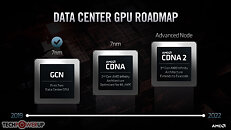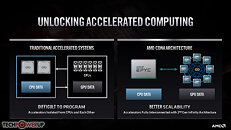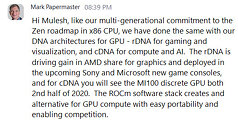Raevenlord
News Editor
- Joined
- Aug 12, 2016
- Messages
- 3,755 (1.17/day)
- Location
- Portugal
| System Name | The Ryzening |
|---|---|
| Processor | AMD Ryzen 9 5900X |
| Motherboard | MSI X570 MAG TOMAHAWK |
| Cooling | Lian Li Galahad 360mm AIO |
| Memory | 32 GB G.Skill Trident Z F4-3733 (4x 8 GB) |
| Video Card(s) | Gigabyte RTX 3070 Ti |
| Storage | Boot: Transcend MTE220S 2TB, Kintson A2000 1TB, Seagate Firewolf Pro 14 TB |
| Display(s) | Acer Nitro VG270UP (1440p 144 Hz IPS) |
| Case | Lian Li O11DX Dynamic White |
| Audio Device(s) | iFi Audio Zen DAC |
| Power Supply | Seasonic Focus+ 750 W |
| Mouse | Cooler Master Masterkeys Lite L |
| Keyboard | Cooler Master Masterkeys Lite L |
| Software | Windows 10 x64 |
Mark Papermaster, chief technology officer and executive vice president of Technology and Engineering at AMD, today confirmed that CDNA is on-track for release in 2H2020 for HPC computing. The confirmation was (adequately) given during Dell's EMC High-Performance Computing Online event. This confirms that AMD is looking at a busy 2nd half of the year, with both Zen 3, RDNA 2 and CDNA product lines being pushed to market.
CDNA is AMD's next push into the highly-lucrative HPC market, and will see the company differentiating their GPU architectures through market-based product differentiation. CDNA will see raster graphics hardware, display and multimedia engines, and other associated components being removed from the chip design in a bid to recoup die area for both increased processing units as well as fixed-function tensor compute hardware. CNDA-based Radeon Instinct MI100 will be fabricated under TSMC's 7 nm node, and will be the first AMD architecture featuring shared memory pools between CPUs and GPUs via the 2nd gen Infinity Fabric, which should bring about both throughput and power consumption improvements to the platform.



View at TechPowerUp Main Site
CDNA is AMD's next push into the highly-lucrative HPC market, and will see the company differentiating their GPU architectures through market-based product differentiation. CDNA will see raster graphics hardware, display and multimedia engines, and other associated components being removed from the chip design in a bid to recoup die area for both increased processing units as well as fixed-function tensor compute hardware. CNDA-based Radeon Instinct MI100 will be fabricated under TSMC's 7 nm node, and will be the first AMD architecture featuring shared memory pools between CPUs and GPUs via the 2nd gen Infinity Fabric, which should bring about both throughput and power consumption improvements to the platform.



View at TechPowerUp Main Site




